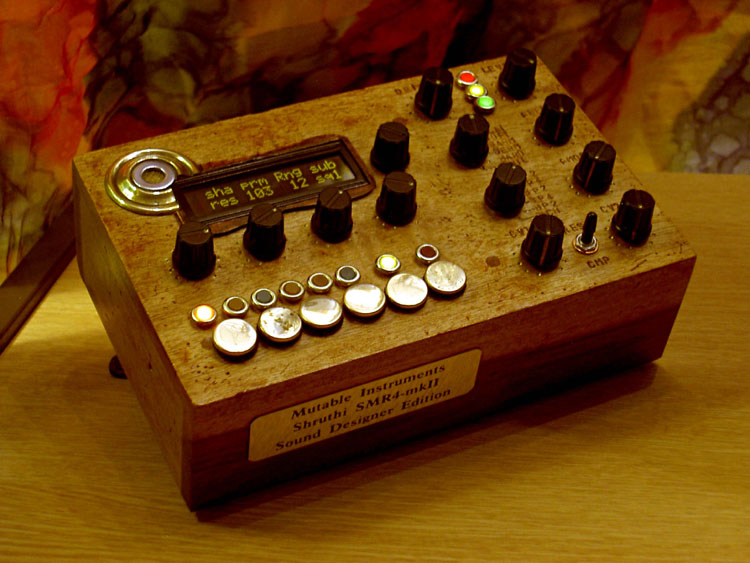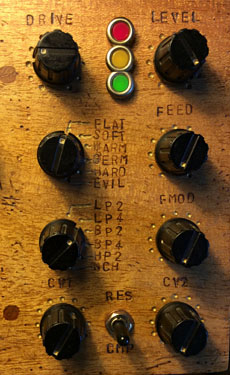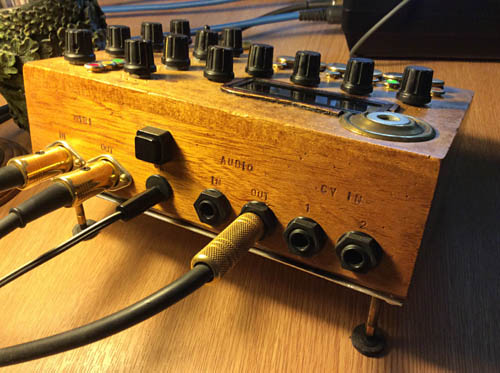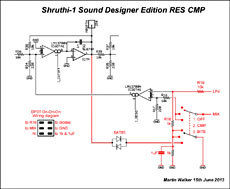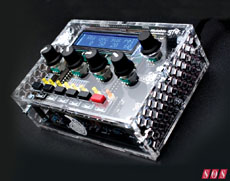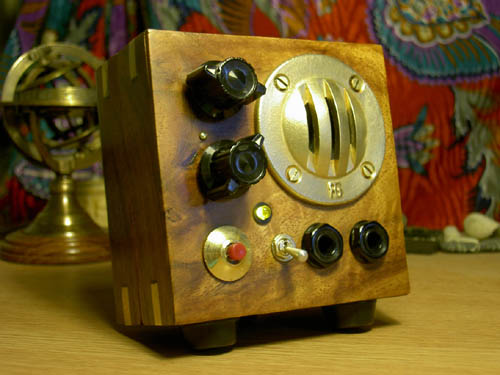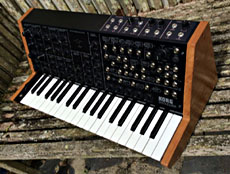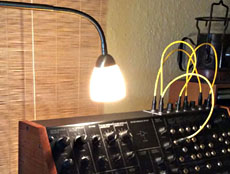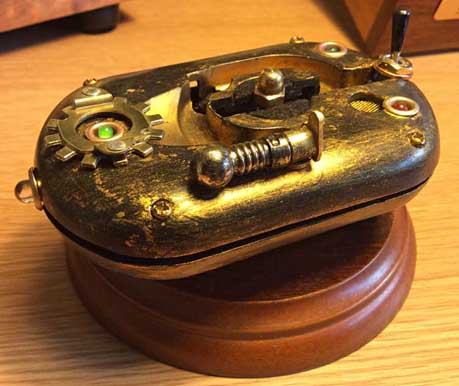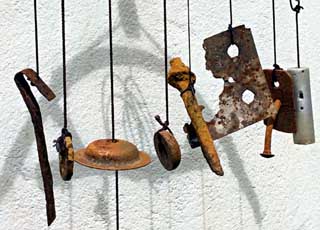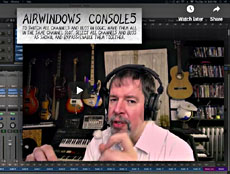SOUNDWORLDS 2: Steampunk Shruthi SDE
MUTABLE INSTRUMENTS
SHRUTHI SMR4-MKII
SOUND DESIGNER EDITION
The sound of some synthesisers is considered almost magical, so when I built one of the excellent and most versatile Mutable Instruments Shruthi MIDI monosynth kits, it seemed a perfect opportunity for me to explore just how far the sound of its analogue filter could be pushed towards that of other famous synth designs, and learn a lot about filter design in the process.
ADDED FLAVOURS
SHAPE: The Shruthi's Roland-inspired SMR4-mkII circuit board provided a warm, classic LP4 24dB/octave lowpass filter, but I was inspired by the very clever pole-mixing options of Mutable Instruments' 4-pole Mission filter design, so I reverse-engineered some of these for the SMR4 to add a harsher 12dB/octave LP2 option, BP2 and BP4 bandpass, HP2 highpass and NCH (notch) options - six switchable filter curves were far more versatile! (lots of audio demos further down this page).
FLAVOUR: Most filters differ in sound far more at high resonance settings than low ones, so I spent several weeks exploring different ways to change the filter 'flavour' by adding assorted diode clipping circuits at various points in the circuitry to achieve softer, warmer and then more obviously harsh resonance characters. In the end I managed to achieve six distinctly different switchable options.
a) FLAT - the original SMR-4 MkII low distortion filter sound (typically less than 0.3% with most Shruthi-1 patches), but running with lower internal signal levels to provide more headroom, resulting in extra IR3109 acid squelch and resonance.
b) SOFT - smooths the edge off any resonance and adds a tiny amount (~1%) of third harmonic distortion.
c) WARM - offers a healthy 6% second harmonic distortion for a thicker, fatter sound.
d) GERM - adds a massive 20% second harmonic distortion and also kills the resonance, using classic Germanium diode limiting.
e) HARD - adds around 6% of predominantly third harmonic and less second for a harder-edged sound with added sub-octave contribution.
f) EVIL - takes things to the ultimate extreme, using pre-filter half-wave rectification for a huge 35% of extra harmonic content, giving a grungy overdrive with lots of high-end grit.
RES CMP: After exploring how various Roland, Moog and Korg filter designs altered their resonance at different frequencies, I added a 3-way switch to mimic these, with the Roland setting compensating for loss of loudness at higher resonance settings, the Moog setting being uncompensated, and the Korg (MS-20 MkII) setting adding a more distorted resonance that increases to a scream at lower frequencies.
FEEDBACK TRICKS
DRIVE: In an effort to add yet more 'dirt' options, I added a variable gain control to the VCA, allowing me to achieve results anywhere from subtle overdrive to very extreme clipping distortion - ideal in conjunction with some of the other mods in recreating particularly 'nasty' filter sounds.
FMOD: For even more dramatic squelchy effects, another circuit modification and additional front panel control allowed the audio signal to directly modulate the filter cutoff frequency - cue rubbery, wobbly sounds and FM mayhem!
FEED: A major breakthrough occurred after reading about the Minimoog trick of feeding this synth's output back to its input to beef it up - I tried this at various circuit points in the Shruthi until I got a wonderfully controllable positive feedback effect ranging from added low-end warmth with smaller amounts, to continuous feedback and locking onto different harmonics as the filter settings change, giving 'circuit-bent' sounds.
CV1/2: The Shruthi design already provided two control voltage inputs for experimenters, so I added two CV sockets on the rear panel to let me patch in external control signals, and two additional front panel pots labeled CV1 & CV2. Without a jack plugged into the rear panel sockets, the Shruthi +5-volt supply was instead connected, to allow real-time performance sweeps of any of the Shruthi internally programmed modulation destinations using the CV1 and CV2 knobs.
CASEWORK: Now I had a monosynth with a hugely versatile sound, so what it now needed was a case that reflected all my mad scientist explorations. For that I returned to my love of steampunk. An old wooden jewellery box was routed out to accommodate all the extra circuitry and controls, given a distressed 'antique' finish, a set of push switches fashioned from brass buttons, top hat LED indicators in brass casings, and with control labels stamped directly into the wood. Finally, I added a traffic-light (red, amber, green) LED ladder meter to keep a wary eye on output level.
Further Information on the Shruthi SMR4-mkII Sound Designer Edition
Shruthi-1 SDE Wiki: Step by step details by Martin on how to make any or all of his SDE circuit modifications, originally published on the Mutable Instruments web site and now saved to the WayBackMachine for posterity.
SOS Shruthi Review: Martin's review of building his standard Shruthi kit, published in Sound On Sound magazine September 2012.
SOUNDWORLDS 1 - Steampunk Buddha Machine: Martin's first exploration of the steampunk world, on this occasion circuit-bending a buddha machine loop player.
SOUNDWORLDS 3 - Korg MS-20 Retro Expansion: This time Martin adds an entirely new front panel containing sixteen additional controls to his Korg MS-20 Mini synth, featuring FM, PWM, Sync, Diode Ring Mod, multiple oscillator waveform outputs & enhanced mixer, as well as some gorgeous cherry hardwood side panels!
SOUNDWORLDS 4 - Steampunk Synth Luminator: To illuminate the controls of his Korg MS-20 Retro Expansion synth, Martin designs a desklamp resplendent in full steampunk regalia.
SOUNDWORLDS 5 - Steampunk Photon Hunter: Another steampunk creation, this fascinating device responds to CHANGES of light level, enabling the capture of completely new soundworlds!
SOUNDWORLDS 6 - The Rustacean : Created from found objects, scavenged from the sea, or rescued from rivers, this artistic creation still manages to produce its own unique audio contribution!
SOUNDWORLDS 7 - Optimising Airwindows Console5: Martin explores ways to achieve the most effective results from this plug-in pair, whose results are subtle yet glorious, adding glue and spacial depth to mixes, and a sense of space around each sound.
Mutable Instruments Shruthi - A classic hybrid digital/analog monosynth with open source credentials
Shruthi lives on as the Phoenix - TubeOhm keep the DIY flag flying since the Shruthi kits were discontinued, with an even more comprehensive choice of filter boards
Yew Tree Magic's Steampunk Shruthi Sound Designer Edition - We feature on the famous MATRIXSYNTH web site
